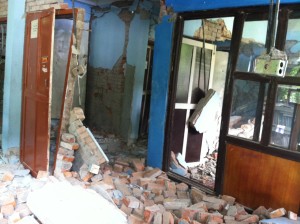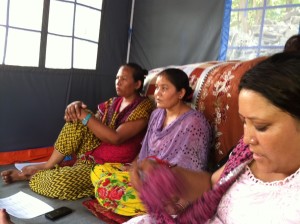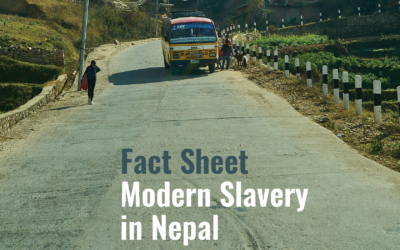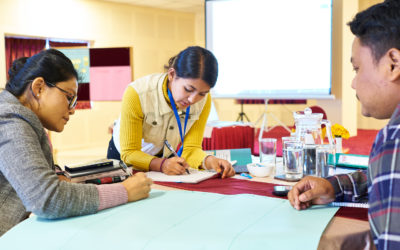First the good news: Free the Slaves and our front-line partners are back at work helping Nepalis resist and overcome trafficking and slavery. Two of our partner organizations have more than doubled in size thanks to emergency funding from international organizations to hire temporary anti-slavery field staffers.
Now the bad news: Nepal’s infrastructure remains in tatters. People are living like refugees inside their own country. Human traffickers are exploiting the situation to prey on the vulnerable. Ongoing aftershocks continue to rattle the unstable hillsides – and people’s nerves.
Free the Slaves Director of Programs Karen Stauss is just back from Nepal, with the following situation update.
FTS Blog: The international response to the human trafficking spike in Nepal after the quake is gearing up, and Free the Slaves front-line partners are part of the solution. Can you update us on what is happening and why our partners are seen as go-to resources?
Karen: GMSP and Shakti Samuha are both operating in districts that are the most affected by the earthquakes. So there is a lot of humanitarian relief that is going to that area by agencies that don’t necessarily know the communities they are trying to help. GMSP in particular knows the district very well, and is known as having access that international NGOs simply don’t have.
So they’ve gone to GMSP to see if they can distribute the material relief for this natural disaster. GMSP is aware that in addition to the lack of housing and lack of food, there is a lack of human rights protection. Trafficking is also a big problem in a post-earthquake setting. GMSP has carried out human trafficking work alongside the distribution of tents, food and other items.

GMSP’s office was destroyed in the April earthquake
The national earthquake relief effort is organized in a cluster system, in which the different agencies working on different aspects of disaster responses cluster together on different issues. There’s a cluster on gender-related issues, child protection, shelter and housing, food and other items. Unfortunately there’re no sub-cluster on human trafficking.
But at the national level, our partner AATWIN has been advocating for inclusion of human trafficking as part of earthquake relief, and they have been advocating that NGOs should include an understanding of human trafficking into their work. So when NGOs go to communities distributing relief materials, they also are helping to let people know how they can protect themselves from human trafficking, which seems to be increasing during this period.
FTS blog: Free the Slaves major donors and foundations have been remarkably flexible in allowing some of their contributions to be spent on stabilizing the infrastructure of our partners’ operations. Can you update us on how that effort is making a difference?

GMSP is currently operating out of tents
Karen: One of the tragic things that has happened is that local anti-trafficking activists are facing the same disaster themselves. About 90 percent of the staff and board members of GMSP lost their own homes. So they went from reasonably-comfortable modest homes, warm and dry, to makeshift tin shacks that are not keeping the rain out. In order for them to help others, they themselves also need to recover from this natural disaster. So Free the Slaves realized that we not only need to pay for their anti-trafficking activities, we also need to be able to sustain their work. We are allowing them to have flexibility with funds, to create temporary offices and improved staff housing — because they won’t be able to do their work if they have to worry about whether their own families will have a safe place to sleep at night.
It’s critical that our grassroots teams are able to confront trafficking in this post-earthquake environment. For example, there are hundreds of cases of children who have lost one or both parents—they are especially vulnerable to trafficking. Two traffickers who were in jail were able to escape during the earthquake and they are now on the loose.
FTS Blog: The earthquake happened more than two months ago, but it sounds like staffers for Free the Slaves and our partner organizations have far from recovered. Can you update us on their physical situation and the psychological trauma that continues with frequent aftershocks?
Karen: One thing I realized on my visit is that most people in Nepal, and certainly those in the most affected districts, are not yet on their way to recover psychologically. The damage is jaw dropping. People are in survival mode physically. And the earthquake itself was very traumatizing. The first earthquake literally lasted for an entire minute. So that was a terrifying experience. People were starting to get back to normal, but then the second one hit, and people started to realize that it’s not a one-time thing. When it happens twice, it can happen a third time, fourth time. And they have experienced a series of aftershocks.

Activists planning anti-trafficking work from makeshift shelters
Not only that, but it is now the monsoon rainy season. And landslides have been worse this year because of the earthquakes. Every morning when people wake up, they start wondering if another family member was killed by landslide. So this type of ongoing harm has been preventing people from recovering psychologically from the trauma of the original incident.
They definitely are being very smart, and taking as many steps as they can to support each other, seeking formal and informal counseling, being there for each other. They are taking concrete steps to feel as good as possible, so they can continue with their anti-slavery work.
Tomorrow in the FTS Blog: the story behind our latest video from Nepal, filmed just before the earthquake, where activists From Free the Slaves and our partner organizations discuss why they work so tirelessly to safeguard fellow Nepalis from traffckers. Read more about Free the Slaves in Nepal and learn how you can take action.
FTS Intern Heather Li contributed to this report.


